Final product of our media opening sequence
Kit Fielder AS Media Blog
Monday, 15 February 2016
Monday, 8 February 2016
Tuesday, 2 February 2016
QUESTION SEVEN:
- Looking back at your preliminary task, what do you feel you have learnt in the progression from it to the full product?
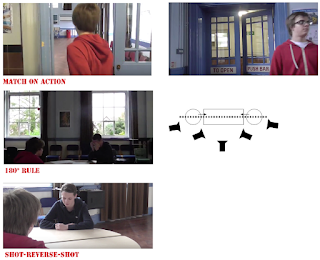 Firstly, the preliminary task taught me about match on action which as a group we thought would suit our opening sequence a lot. The preliminary task also influenced how we would handle sound, as we wanted our opening sequence.
Firstly, the preliminary task taught me about match on action which as a group we thought would suit our opening sequence a lot. The preliminary task also influenced how we would handle sound, as we wanted our opening sequence.
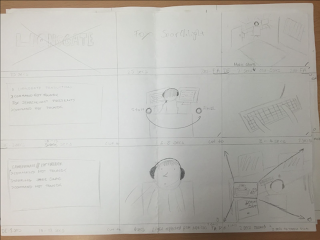 Our Planning first began by as a group sharing our ideas on what we thought our opening sequence should be about. We all shared similar ideas and after coming up with a rough narrative we worked together on deciding how we could clearly show our intentions through our opening and continue to make it fit within the Coming of Age genre. Once we had come up with a secure plot we started to make a storyboard which would allow us to all share a similar image of what out opening would look like exactly. Following on from our storyboard we started we write a script and create a character profile. Each member of the group took a different task so that our progress would be quicker and once we had finished we would just share it with each other. From these tasks I learnt that we need to be realistic with our creations as our aim was to make a character that the audience can relate with. As our opening contained on dialog our script consisted of only stage directions.
Our Planning first began by as a group sharing our ideas on what we thought our opening sequence should be about. We all shared similar ideas and after coming up with a rough narrative we worked together on deciding how we could clearly show our intentions through our opening and continue to make it fit within the Coming of Age genre. Once we had come up with a secure plot we started to make a storyboard which would allow us to all share a similar image of what out opening would look like exactly. Following on from our storyboard we started we write a script and create a character profile. Each member of the group took a different task so that our progress would be quicker and once we had finished we would just share it with each other. From these tasks I learnt that we need to be realistic with our creations as our aim was to make a character that the audience can relate with. As our opening contained on dialog our script consisted of only stage directions.
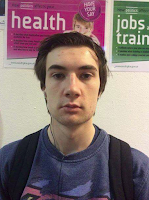 Before it came to filming the actual footage we needed to decide on the location and an actor. These decisions were quite easy to chose as we knew an exact location that would suit our opening sequence. When choosing an actor we decided to pick someone that fit a character criteria and who would definitely be available. From this I learnt that it is best to chose a location that is easily accessible for our group and the actor. The only problem we had was deciding on a time and date that everyone was available for. The benefit of our location was that the weather or time of day didn't dramatically effect any of our filming as it all took part inside, this was handy was we weren't able to get all our footage in one go.
Before it came to filming the actual footage we needed to decide on the location and an actor. These decisions were quite easy to chose as we knew an exact location that would suit our opening sequence. When choosing an actor we decided to pick someone that fit a character criteria and who would definitely be available. From this I learnt that it is best to chose a location that is easily accessible for our group and the actor. The only problem we had was deciding on a time and date that everyone was available for. The benefit of our location was that the weather or time of day didn't dramatically effect any of our filming as it all took part inside, this was handy was we weren't able to get all our footage in one go.
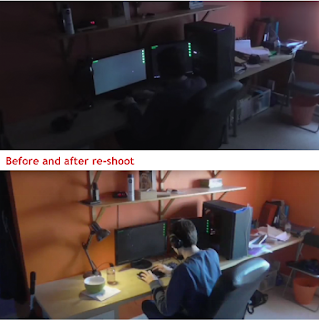
We had to re-film our opening sequence as in our first take we were unhappy with the lighting and we needed a wider range of shots, so we made some alterations and filmed it in a brighter light. When recording our footage we made sure to get a range of different camera angles to that we count make our opening more interesting. From this I learnt that it is important to note where everything is in each shot. I also learnt that by having a variety of camera angles allows you to me more free with your editing and try different things to see how they would look.
Looking back at my preliminary task I have gone through the process of filming and editing an opening sequence, and since doing my preliminary task I have learnt a collection of things thats help me out.
 Firstly, the preliminary task taught me about match on action which as a group we thought would suit our opening sequence a lot. The preliminary task also influenced how we would handle sound, as we wanted our opening sequence.
Firstly, the preliminary task taught me about match on action which as a group we thought would suit our opening sequence a lot. The preliminary task also influenced how we would handle sound, as we wanted our opening sequence. Our Planning first began by as a group sharing our ideas on what we thought our opening sequence should be about. We all shared similar ideas and after coming up with a rough narrative we worked together on deciding how we could clearly show our intentions through our opening and continue to make it fit within the Coming of Age genre. Once we had come up with a secure plot we started to make a storyboard which would allow us to all share a similar image of what out opening would look like exactly. Following on from our storyboard we started we write a script and create a character profile. Each member of the group took a different task so that our progress would be quicker and once we had finished we would just share it with each other. From these tasks I learnt that we need to be realistic with our creations as our aim was to make a character that the audience can relate with. As our opening contained on dialog our script consisted of only stage directions.
Our Planning first began by as a group sharing our ideas on what we thought our opening sequence should be about. We all shared similar ideas and after coming up with a rough narrative we worked together on deciding how we could clearly show our intentions through our opening and continue to make it fit within the Coming of Age genre. Once we had come up with a secure plot we started to make a storyboard which would allow us to all share a similar image of what out opening would look like exactly. Following on from our storyboard we started we write a script and create a character profile. Each member of the group took a different task so that our progress would be quicker and once we had finished we would just share it with each other. From these tasks I learnt that we need to be realistic with our creations as our aim was to make a character that the audience can relate with. As our opening contained on dialog our script consisted of only stage directions. Before it came to filming the actual footage we needed to decide on the location and an actor. These decisions were quite easy to chose as we knew an exact location that would suit our opening sequence. When choosing an actor we decided to pick someone that fit a character criteria and who would definitely be available. From this I learnt that it is best to chose a location that is easily accessible for our group and the actor. The only problem we had was deciding on a time and date that everyone was available for. The benefit of our location was that the weather or time of day didn't dramatically effect any of our filming as it all took part inside, this was handy was we weren't able to get all our footage in one go.
Before it came to filming the actual footage we needed to decide on the location and an actor. These decisions were quite easy to chose as we knew an exact location that would suit our opening sequence. When choosing an actor we decided to pick someone that fit a character criteria and who would definitely be available. From this I learnt that it is best to chose a location that is easily accessible for our group and the actor. The only problem we had was deciding on a time and date that everyone was available for. The benefit of our location was that the weather or time of day didn't dramatically effect any of our filming as it all took part inside, this was handy was we weren't able to get all our footage in one go.
We had to re-film our opening sequence as in our first take we were unhappy with the lighting and we needed a wider range of shots, so we made some alterations and filmed it in a brighter light. When recording our footage we made sure to get a range of different camera angles to that we count make our opening more interesting. From this I learnt that it is important to note where everything is in each shot. I also learnt that by having a variety of camera angles allows you to me more free with your editing and try different things to see how they would look.
After filming I felt that my camera handling skills and improved and were much better than when I did my preliminary task, When looking over our footage I felt that it looked a lot cleaner. When editing I learnt how important it is for your font to match with your narrative. This made it difficult to find the right font that would look good. To find the right font, one of us researched and tested out title names with multiple types of fonts.
QUESTION SIX:
- What have you learnt about technologies from the process of constructing this product?
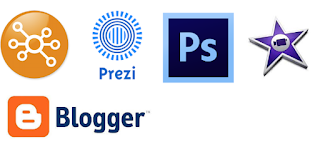

From the process of constructing I have learnt how to use different technologies such as Imovie, Blogger, Prezi, Spiderscribe, Sound, Photoshop Timeline and recording with a camera.
From Imovie I have learnt how to edit my footage and make the correct adjustments in order to make it look like a film. After uploading the raw footage to Imovie and putting it together I have learnt that we cut down a lot of the original shot and are left with very little, for example a 11 second shot should be cut down to 2-3 seconds. This is because if a shot lasts too long then the audience will start to get bored, so it it best to have lots of quick sharp shots which consist of lot of different camera angles. From Sound I have learnt that all music creates different types of mood and atmosphere, which made it hard to find the best one to fit out opening sequence. When editing out footage we thought that combing diegetic and non-diegetic sounds would improve how our opening and make it smoother.
Blogger, Prezi and Spiderscribe. These are only a few of the ways I chose to feedback my research and an example of what I have learnt is thats it is much more effective to give people and electronic questionnaire as they are much more likely to fill it out than a paper based one. I have also learnt that Prezi is a very good way of uploading your power points to your blog as it makes it makes it a lot easier for people to view.
Spiderscribe allowed me to make clear and easy to read mind-maps. I was also able to add pictures and videos to provide extra information. It was an easy to use website which allowed me to easy share ideas with my partners.


Spiderscribe allowed me to make clear and easy to read mind-maps. I was also able to add pictures and videos to provide extra information. It was an easy to use website which allowed me to easy share ideas with my partners.


I have also learnt that by using a video camera there are many different techniques to make the best kind of footage such as camera angles, movements and positioning. I have learnt that there are multiple camera angles which can all give the content of the shot a different meaning towards the audience. An example of some camera angles are medium shots, close ups, long shots and wide shots. I have also learnt about the 180 degree rule and how to film a match on action shot.
QUESTION FOUR:
- Who would be the audience for your media product?
The primary target audience of our media project is male teenagers who have an interest in comic books and computers, this is because the narrative of our opening sequence is a lot easier for teenagers to relate with as it features a teenager as the main protagonist who sends the entire of the opening at his computer, which is appealing for people interested in technology and computers. Teenagers are our target audience as our media project is the opening to a Coming of Age genre film. The clothing choices make our opening appealing to comic book enthusiasts as they would share a interest with our character.
Our secondary audience includes a wide range of people as we are able to engage people for all ages who might be interesting in computers and technology in general. We are also able to attract people who have an interest in drama and comedy genre films as our character is presented as a mysterious characters as not much of his personality is revealed in the opening, so this will attract an audience that are interesting in character driven films and just finding out about their backstory.
VOKI transcript:
"Hi, my name is Ryan Davies, I'm 16 and share an interest in computing and programming with the main character of FIREWALL. I really enjoyed the film as I was able to relate to the to the main character in so many different ways, including interests, social status and age. The narrative made the film more enjoyable and captivating even though it covered such an extreme storyline. In addition, FIREWALL was really relatable as it was a character driven plot which covered similar personal situations to my own and made underlining messages which were clear to all the audience."
QUESTION THREE:
- What kind of media institution might distribute your media product and why?
The type of Institution that we have chosen to distribute our film is Fox Searchlight Pictures. They have around 115 titles since 1994 and have a revenue of $6.50 million. They specialize in independent and British films. Fox Searchlight have distributed Many films of a similar genre to ours, such as Juno, which had a $6.5 -$7 million budget and in Box office made $231,411,584. As they have released so many films it will able us to gain and attract a larger audience.
By having them distribute our film, it would allows us to reach an American audience and therefor gain more viewer. Another reason why we have chosen them to distribute out film is because they are a big company which have made millions from independent films such as Slumdog Millionaire, which in Box Office made $377.9 million.
I am hoping to engage people into the film by using multiple forms of advertisement. This would allow a good variety of people to see the trailers and become interested in the film and its narrative.
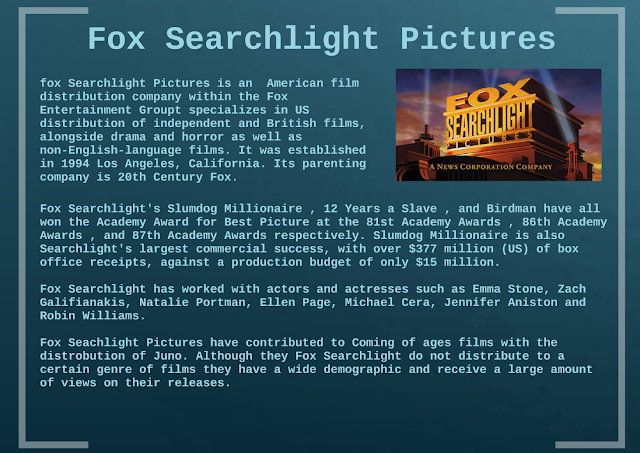
Ways in which we would be able to expand our audience through advertisment by having Fox Searchlight Pictures as our distributor are;
By having them distribute our film, it would allows us to reach an American audience and therefor gain more viewer. Another reason why we have chosen them to distribute out film is because they are a big company which have made millions from independent films such as Slumdog Millionaire, which in Box Office made $377.9 million.
I am hoping to engage people into the film by using multiple forms of advertisement. This would allow a good variety of people to see the trailers and become interested in the film and its narrative.

Ways in which we would be able to expand our audience through advertisment by having Fox Searchlight Pictures as our distributor are;
- TV trailers
- Social media, e.g. Snapchat, Facebook, Twitter, Instagram and tumbler.
- Billboards
- Radio
- Emails
- Website advertisement
- Cinema advertisment
Subscribe to:
Comments (Atom)



